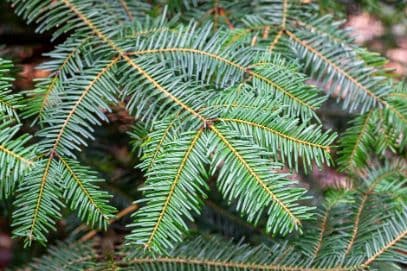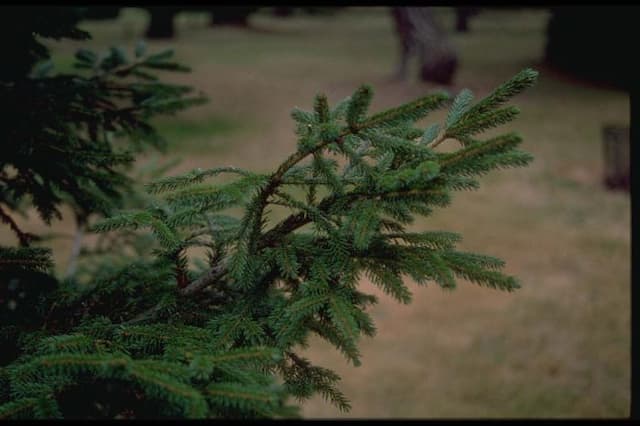Norway spruce Picea abies

ABOUT
The Norway spruce is a large, evergreen tree that can reach heights of 100 to 200 feet. It has a conical shape with a straight trunk and a naturally occurring pyramid-like form. The branches are whorled and horizontally spread, often drooping slightly at their tips. The tree's needles are about half an inch to an inch long, sharp, and somewhat four-sided, ranging in color from bright to dark green. They cover the branches densely, giving the tree a full, lush appearance. The Norway spruce also produces cylindrical cones that are four to six inches long, which hang down from the branches and are initially green before turning brown as they mature.
About this plant
 Names
NamesFamily
Pinaceae
Synonyms
Norway Spruce, European Spruce
Common names
Abies excelsa, Pinus abies, Picea excelsa, Picea vulgaris, Pinus pyramidalis, Pinus abies var. europaea, Picea abies var. europaea, Picea abies var. pendula, Picea abies f. aurea, Picea abies f. pendula, Picea abies f. virgata, Picea abies f. tortuosa, Abies picea.
 Characteristics
CharacteristicsLife cycle
Perennials
Foliage type
Evergreen
Color of leaves
Green
Height
98 feet (30 meters)
Spread
20 feet (6 meters)
Plant type
Tree
Hardiness zones
3
Native area
Europe
Benefits
 General Benefits
General Benefits- Ornamental Use: Often used as a Christmas tree or as an ornamental plant in landscaping due to its classic conifer shape and dense, evergreen foliage.
- Timber Production: Provides high-quality wood that is used for construction, furniture, and paper production.
- Erosion Control: Its root system helps stabilize soil and control erosion on slopes and in sensitive areas.
- Wildlife Habitat: Offers habitat and shelter for various species of wildlife, including birds and small mammals.
- Climate Resilience: Adaptable to a range of climates, which makes it a versatile species for reforestation and afforestation projects.
- Shade and Shelter: Provides shade in summer and acts as a windbreak during harsh winters, improving energy efficiency for nearby homes.
- Recreational Use: Used in outdoor recreation areas, contributing to the aesthetic value and natural appeal of parks and forests.
- Cultural Significance: Holds importance in various cultures, featuring in traditions and folklore, especially in Europe.
- Carbon Sequestration: Contributes to carbon sequestration, helping to mitigate the effects of climate change by absorbing CO2 from the atmosphere.
 Medical Properties
Medical Properties- Respiratory aid - Picea abies, commonly known as Norway spruce, has been used in traditional medicine for its expectorant properties, helping to alleviate coughs and other respiratory ailments.
- Anti-inflammatory - The resin from Norway spruce has been applied topically to reduce inflammation and soothe irritated skin conditions.
- Antiseptic - Norway spruce's resin and essential oil have been used for their antiseptic properties to treat minor wounds and prevent infection.
- Analgesic - The plant has been used in traditional remedies to relieve pain, especially muscular and joint aches.
- Immune system support - Preparations made from the needles or shoots of the plant are believed to enhance the immune system.
 Air-purifying Qualities
Air-purifying QualitiesThis plant is not specifically known for air purifying qualities.
 Other Uses
Other Uses- Norway spruce wood is often used in the production of musical instruments, especially violins, cellos, and guitars, due to its tonal qualities and resonance.
- Due to its dense and uniform wood fibers, the timber from Norway spruce is suitable for pulp and paper manufacturing.
- The resin extracted from Norway spruce can be used in the production of rosin for stringed instrument bows and various adhesives.
- Young shoots and soft parts of Norway spruce can be used for the production of spruce beer, a type of beverage with a distinctive flavor.
- Norway spruce cones are employed in crafting decorations, especially during Christmas time for wreaths and ornaments.
- The wood of Norway spruce is commonly used in constructing aircraft, due to its strength-to-weight ratio and workability.
- In landscape architecture, Norway spruce is planted for its fast-growing nature and as a windbreak in colder climates.
- The wood is also utilized in the creation of crates and packaging materials because of its availability and relatively low cost.
- The soundboards made from Norway spruce are prized in piano construction for their sound projection and clarity.
- The bark and wood chips of Norway spruce can be used as mulch for gardening, providing soil moisture retention and temperature regulation.
Interesting Facts
 Feng Shui
Feng ShuiThe Norway spruce is not used in Feng Shui practice.
 Zodiac Sign Compitability
Zodiac Sign CompitabilityThe Norway spruce is not used in astrology practice.
 Plant Symbolism
Plant Symbolism- Longevity and Immortality: The Norway spruce is known for its long lifespan, surviving for centuries. It symbolizes endurance and the ability to stand the test of time.
- Resilience: This spruce is able to grow in challenging environments, symbolizing resilience and the capacity to overcome adversity.
- Growth and Vitality: The evergreen nature of the Norway spruce represents continuous growth, vitality, and the cycle of life.
- Protection: Its sturdy nature suggests a protective quality, sheltering the ecosystems that depend on it.
- Purification: The aromatic scent of the needles and its association with clean, forest air implies purification and renewal.
- Festivity and Celebration: Often used as a Christmas tree, the Norway spruce evokes feelings of festivity, tradition, and the joy of gatherings.
 Water
WaterThe Norway Spruce (Picea abies) should be watered deeply and infrequently to encourage strong root growth. During the first year after planting, providing 1-2 gallons of water per week is essential, depending on the rainfall and soil conditions. After establishment, they are quite drought-tolerant and generally require water only during prolonged dry spells. During hot or dry weather, a good soaking every two to three weeks is beneficial. Make sure to water at the base of the tree, avoiding wetting the foliage to help prevent disease.
 Light
LightNorway Spruce thrives in full sunlight, meaning at least six hours of direct, unfiltered sunlight each day. The best spot for a Norway Spruce is an open area with ample space for its large size at maturity. Avoid planting in heavily shaded areas, as this can lead to poor growth and sparse foliage.
 Temperature
TemperatureNorway Spruce can withstand cold, with a hardiness down to -40 degrees Fahrenheit, and it can grow comfortably in areas where the temperature ranges from 120 to 130 degrees Fahrenheit for maximum to minimum. The ideal growing conditions for this spruce are cool summers and cold winters, as extreme heat can stress the plant.
 Pruning
PruningPruning is not necessary for the health of a Norway Spruce, but it may be done for aesthetic reasons or to remove damaged limbs. The best time to prune is in late winter or early spring before new growth begins. Pruning should be done sparingly, focusing on dead or broken branches, and maintaining a natural pyramidal form. Regular pruning to shape the tree is not usually recommended, to preserve its natural appearance.
 Cleaning
CleaningAs needed
 Soil
SoilNorway Spruce prefers well-drained, sandy loam soil with a slightly acidic to neutral pH, typically between 5.5 and 7.0. The best soil mix can be created by combining two parts loam, one part peat moss, and one part sand or perlite to ensure good drainage while retaining adequate moisture.
 Repotting
RepottingNorway Spruce, being a large tree, is not commonly repotted as it is usually planted directly in the ground. Repotting is generally not applicable, but young trees in nursery containers should be planted in a permanent location with ample space to grow.
 Humidity & Misting
Humidity & MistingNorway Spruce thrives best in outdoor conditions where it can receive natural humidity. It does not require any specific humidity levels, but it is adapted to withstand the varying humidity levels of temperate climates where it naturally grows.
 Suitable locations
Suitable locationsIndoor
Not ideal indoors; requires ample space, sun.
Outdoor
Plant in full sun, well-draining soil, space to grow.
Hardiness zone
2-7 USDA
 Life cycle
Life cycleNorway spruce (Picea abies) begins its life cycle when seeds, housed within cones, are dispersed often by wind or animals. Upon finding suitable soil, the seeds germinate, and a young spruce sapling emerges, going through a period of rapid growth characterized by the development of a strong root system and a straight, upward-growing stem. As it matures, the spruce develops a conical shape with whorled branches and needle-like leaves. After about 20 to 40 years, the Norway spruce reaches reproductive maturity and starts producing male and female cones; the male cones release pollen which is carried by wind to the female cones, leading to fertilization. After fertilization, seeds develop within the female cones and, once ripe, are released to start a new generation. The Norway spruce can live for several hundred years, with some individuals reaching over 400 years of age, continuously reproducing and contributing to forest ecosystems.
 Propogation
PropogationPropogation time
Late winter-early spring
The most common name for Picea abies is Norway spruce, and its most popular method of propagation is through seed sowing. Ideal propagation time is usually during late winter or early spring when the temperature starts to become conducive for seed germination. To propagate Norway spruce by seeds, one should first stratify the seeds by keeping them in a cold environment, at approximately 34 to 41 degrees Fahrenheit (1 to 5 degrees Celsius), for about 3 to 4 weeks to break dormancy. After stratification, the seeds can be sown in well-draining soil in a container or a nursery bed. The soil should be kept consistently moist but not waterlogged to facilitate germination. Once the seedlings grow strong enough, they can then be transplanted to their permanent locations, taking care to protect them from extreme elements and ensuring they have enough space to grow.









